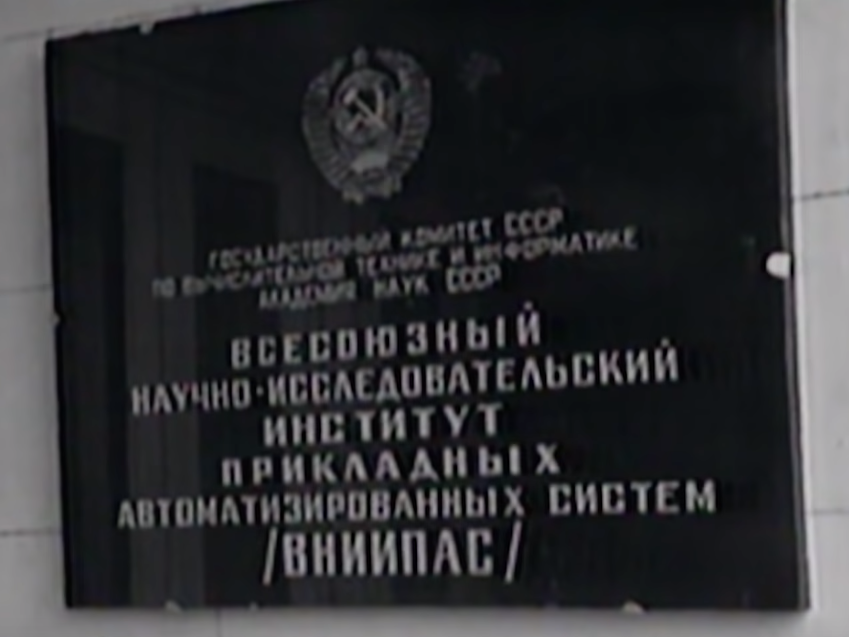|
Akademset
Akademset (, Academic Network), or All-USSR, Union Academic network — was a computer network for providing Digital signal, digital connection of scientific and civil institutions across the USSR, that was established in 1978. In fact, it was a Soviet History of the Internet, forerunner to the Internet and had a connection with ARPANET and other western analogues using the common digital standard called X.25. After dissolution of the Soviet Union it was re-created under the name ROKSON (РОКСОН),Академическая компьютерная сеть С.-Петербурга �— журнал «Электросвязь» № 5, 2003 г., стр. 17. and nowadays its surviving components may be considered as a local area network within the Runet an ... [...More Info...] [...Related Items...] OR: [Wikipedia] [Google] [Baidu] |
OGAS
OGAS (, "National Automated System for Computation and Information Processing") was a Soviet project to create a nationwide information network. The project began in 1962 but was denied necessary funding in 1970. It was one of a series of socialist attempts to create a nationwide cybernetic network. The US government in 1962 regarded the project as a major threat due to the “tremendous increments in economic productivity” which could disrupt the world market. Arthur Schlesinger Jr, historian and special assistant to President Kennedy, described “an all out Soviet commitment to cybernetics” as providing the Soviet Union a “tremendous advantage” in respect to production technology, complex of industries, feedback control and self-teaching computers. Concept The primary architect of OGAS was Viktor Glushkov. A previous proposal for a national computer network to improve central planning, Anatoly Kitov's Economic Automated Management System, had been rejected in ... [...More Info...] [...Related Items...] OR: [Wikipedia] [Google] [Baidu] |
VNIIPAS
The All Union Scientific Research Institute for Applied Automated Systems (VNIIPAS/ВНИИПАС) was a Soviet research institute that provided a computer network service, including international digital connections. It was the central node of inner USSR scientific data network called Akademset. VNIIPAS derived from 1976-established VNIISI/ВНИИСИ which was a partner project of Austrian International Institute for Applied Systems Analysis (IIASA). History The IIASA at Laxenburg, Austria was created in 1972 as a joint USSR-USA effort to establish global scientific communications through the Club of Rome. VNIIPAS operated from 1982 until 1995. In 1983 VNIIPAS, Joel Schatz, Don Carlson, Michael Kleeman, Chet Watson, and George Soros created the joint telecommunication venture ''San Francisco — Moscow Teleport'' (SFMT), later known as '' Sovam Teleport'' ("Soviet-American teleport") that operated digital connections between USSR and USA and later became the SWIFT Swift o ... [...More Info...] [...Related Items...] OR: [Wikipedia] [Google] [Baidu] |
Research Institution
A research institute, research centre, or research organization is an establishment founded for doing research. Research institutes may specialize in basic research or may be oriented to applied research. Although the term often implies natural science research, there are also many research institutes in the social science as well, especially for sociological and historical research purposes. Famous research institutes In the early medieval period, several astronomical observatories were built in the Islamic world. The first of these was the 9th-century Baghdad observatory built during the time of the Abbasid caliph al-Ma'mun, though the most famous were the 13th-century Maragheh observatory, and the 15th-century Ulugh Beg Observatory. The Kerala School of Astronomy and Mathematics was a school of mathematics and astronomy founded by Madhava of Sangamagrama in Kerala, India. The school flourished between the 14th and 16th centuries and the original discoveries of the sch ... [...More Info...] [...Related Items...] OR: [Wikipedia] [Google] [Baidu] |
Cybernetics In The Soviet Union
Cybernetics in the Soviet Union had its own particular characteristics, as the study of cybernetics came into contact with the dominant scientific ideologies of the Soviet Union and the nation's economic and political reforms: from the unmitigated anti-Americanist criticism of cybernetics in the early 1950s; its legitimization after Stalin's death and up to 1961; its total saturation of Soviet academia in the 1960s; and its eventual decline through the 1970s and 1980s. Initially, from 1950 to 1954, the reception of cybernetics by the Soviet Union establishment was exclusively negative. The Soviet Department for Agitation and Propaganda had called for anti-Americanism to be intensified in Soviet media, and in an attempt to fill the Department's quotas, Soviet journalists latched on to cybernetics as an American "reactionary pseudoscience" to denounce and mock. This attack was interpreted as a signal of an official attitude to cybernetics, so, under Joseph Stalin's premiership, ... [...More Info...] [...Related Items...] OR: [Wikipedia] [Google] [Baidu] |
ARPANET
The Advanced Research Projects Agency Network (ARPANET) was the first wide-area packet-switched network with distributed control and one of the first computer networks to implement the TCP/IP protocol suite. Both technologies became the technical foundation of the Internet. The ARPANET was established by the Advanced Research Projects Agency (now DARPA) of the United States Department of Defense. Building on the ideas of J. C. R. Licklider, Robert Taylor (computer scientist), Bob Taylor initiated the ARPANET project in 1966 to enable resource sharing between remote computers. Taylor appointed Lawrence Roberts (scientist), Larry Roberts as program manager. Roberts made the key decisions about the request for proposal to build the network. He incorporated Donald Davies' concepts and designs for packet switching, and sought input from Paul Baran on dynamic routing. In 1969, ARPA awarded the contract to build the Interface Message Processors (IMPs) for the network to Bolt Berane ... [...More Info...] [...Related Items...] OR: [Wikipedia] [Google] [Baidu] |
Hudson Institute
Hudson Institute is an American Conservatism in the United States, conservative think tank based in Washington, D.C. It was founded in 1961 in Croton-on-Hudson, New York, by futurist Herman Kahn and his colleagues at the RAND Corporation. Kahn was a physicist and military consultant known for envisioning nuclear war scenarios. The institute's research branched out from the military into various areas including economics, health, education, and gambling. Kahn died in 1983 and the institute moved to Indianapolis the year after. The institute helped design Wisconsin's influential workfare program in the mid-1990s. Hudson relocated to Washington, D.C., in 2004. It has been noted for work with governments and industries including defense and agribusiness. History 1961–1982 Hudson Institute was founded in 1961 by Herman Kahn, Max Singer, and Oscar M. Ruebhausen. Kahn was a Cold War icon, often interviewed in magazines, who was purported to have the highest IQ on record and partly ... [...More Info...] [...Related Items...] OR: [Wikipedia] [Google] [Baidu] |
Communist Party Of The USSR
The Communist Party of the Soviet Union (CPSU),. Abbreviated in Russian as КПСС, ''KPSS''. at some points known as the Russian Communist Party (RCP), All-Union Communist Party and Bolshevik Party, and sometimes referred to as the Soviet Communist Party (SCP), was the founding and ruling political party of the Soviet Union. The CPSU was the sole governing party of the Soviet Union until 1990 when the Congress of People's Deputies modified Article 6 of the 1977 Soviet Constitution, which had previously granted the CPSU a monopoly over the political system. The party's main ideology was Marxism–Leninism. The party was outlawed under Russian President Boris Yeltsin's decree on 6 November 1991, citing the 1991 Soviet coup attempt as a reason. The party started in 1898 as part of the Russian Social Democratic Labour Party. In 1903, that party split into a Menshevik ("minority") and Bolshevik ("majority") faction; the latter, led by Vladimir Lenin, is the direct ancestor of ... [...More Info...] [...Related Items...] OR: [Wikipedia] [Google] [Baidu] |
OSI Model
The Open Systems Interconnection (OSI) model is a reference model developed by the International Organization for Standardization (ISO) that "provides a common basis for the coordination of standards development for the purpose of systems interconnection." In the OSI reference model, the components of a communication system are distinguished in seven abstraction layers: Physical, Data Link, Network, Transport, Session, Presentation, and Application. The model describes communications from the physical implementation of transmitting bits across a transmission medium to the highest-level representation of data of a distributed application. Each layer has well-defined functions and semantics and serves a class of functionality to the layer above it and is served by the layer below it. Established, well-known communication protocols are decomposed in software development into the model's hierarchy of function calls. The Internet protocol suite as defined in and is a model of net ... [...More Info...] [...Related Items...] OR: [Wikipedia] [Google] [Baidu] |
Brussels
Brussels, officially the Brussels-Capital Region, (All text and all but one graphic show the English name as Brussels-Capital Region.) is a Communities, regions and language areas of Belgium#Regions, region of Belgium comprising #Municipalities, 19 municipalities, including the City of Brussels, which is the capital of Belgium. The Brussels-Capital Region is located in the central portion of the country. It is a part of both the French Community of Belgium and the Flemish Community, and is separate from the Flemish Region (Flanders), within which it forms an enclave, and the Walloon Region (Wallonia), located less than to the south. Brussels grew from a small rural settlement on the river Senne (river), Senne to become an important city-region in Europe. Since the end of the Second World War, it has been a major centre for international politics and home to numerous international organisations, politicians, Diplomacy, diplomats and civil servants. Brussels is the ''de facto' ... [...More Info...] [...Related Items...] OR: [Wikipedia] [Google] [Baidu] |
Socialist Countries
A socialist state, socialist republic, or socialist country is a sovereign state constitutionally dedicated to the establishment of socialism. This article is about states that refer to themselves as socialist states, and not specifically about communist states that refer to themselves as socialist states. It includes information on liberal democratic states with constitutional references to socialism as well as other state formations that have referred to themselves as socialist. Overview Constitutional references to socialism A number of countries make references to socialism in their constitutions that are not single-party states embracing Marxism–Leninism and planned economies. In most cases, these are constitutional references to the building of a socialist society and political principles that have little to no bearing on the structure and guidance of these country's machinery of government and economic system. The preamble to the 1976 Constitution of Portuga ... [...More Info...] [...Related Items...] OR: [Wikipedia] [Google] [Baidu] |
International Institute For Applied Systems Analysis
The International Institute for Applied Systems Analysis (IIASA) is an independent International research institute located in Laxenburg, near Vienna in Austria, founded as an East-West scientific cooperation initiative during the Cold War. Through its research programs and initiatives, the institute conducts policy-oriented interdisciplinary research into issues too large or complex to be solved by a single country or academic discipline. These include climate change, energy security, population aging, and sustainable development. The results of IIASA research and the expertise of its researchers are made available to policymakers worldwide to help them make informed and evidence-based policies. Organization Nearly 500 researchers from 50 countries currently work with the institute. IIASA's international and interdisciplinary network includes staff, alumni, member communities, collaborators, diplomatic partners, and visiting fellows. Hans Joachim "John" Schellnhuber is the ... [...More Info...] [...Related Items...] OR: [Wikipedia] [Google] [Baidu] |





